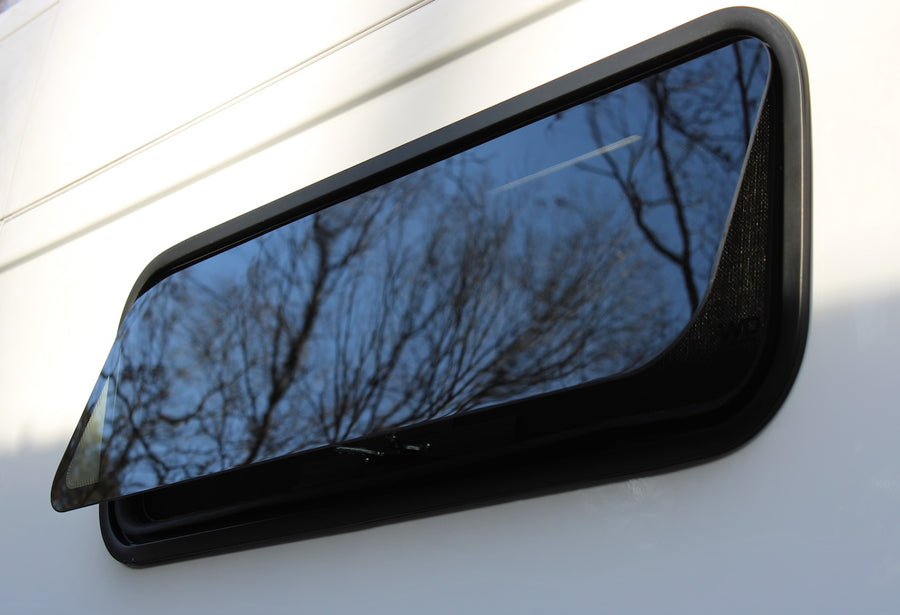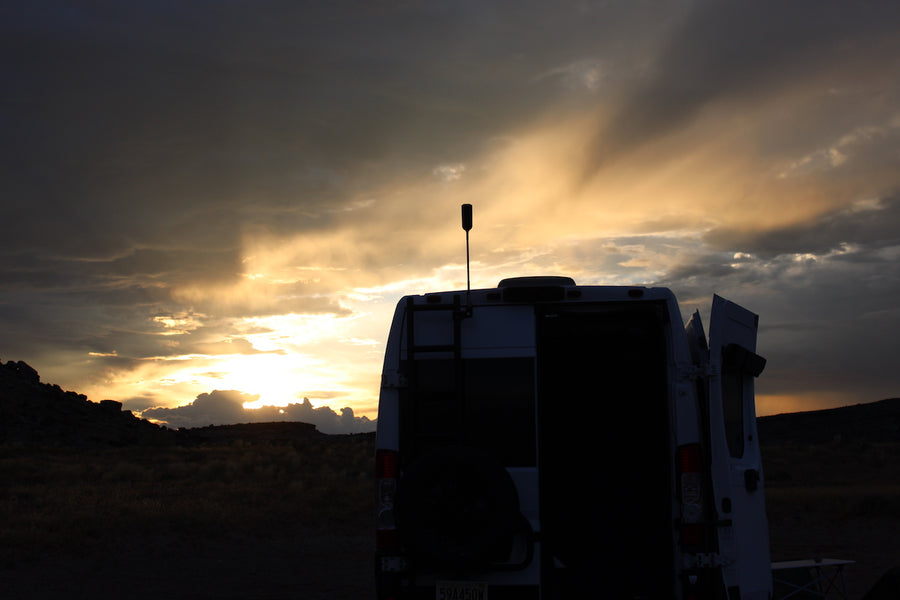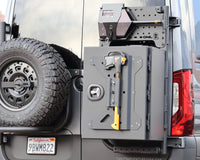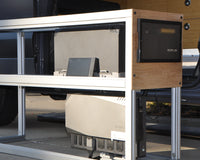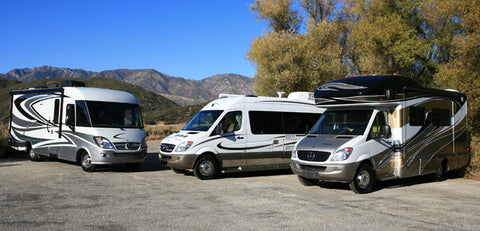
Building your own camper van is an exciting challenge. If you have the time, it's well worth the effort to produce a design that fits your needs exactly. Doing it yourself can be a great source of pride, and if done right, you can save a great deal of money in the process!
I've written a 378-page book about converting vans into camper vans, the Sprinter RV Conversion Sourcebook. In this 15-post Campervan HQ series, we'll outline some of the same design and equipment considerations that I discuss in the book. I hope you find it useful!
The posts will cover:
- Camper Vans Part 1: What's Your Camping Lifestyle?
- Camper Vans Part 2: Renting a Camper Van/Motorhome
- Camper Vans Part 3: Planning the Interior Layout
- Camper Vans Part 4: Choosing (and Finding) a Base Van
- Camper Vans Part 5: Starting the Build
- Camper Vans Part 6: Adding Windows
- Camper Vans Part 7: Adding Soundproofing and Insulation
- Camper Vans Part 8: Adding Wiring
- Camper Vans Part 9: Adding Heat
- Camper Vans Part 10: Adding Plumbing
- Camper Vans Part 11: Adding Interior Paneling
- Camper Vans Part 12: Adding Cabinetry
- Camper Vans Part 13: Adding Beds
- Camper Vans Part 14: Adding Upholstery
- Camper Vans Part 15: Exterior Modifications
Camper Vans: What's Your Camping Lifestyle?
Nowadays so many people are considering the idea of traveling in some kind of recreational vehicle (RV), motivated by many factors:
- the COVID pandemic, and wanting to still be able to travel for shorter and longer trips without fear of catching the latest variant of the virus
- layoffs, which might give you an unexpected silver lining: time to finally go on that trip of a lifetime you've been thinking about for years
- all those Instagram posts and YouTube videos where you see people exploring wilderness areas and other countries from the comfort of their camper van. Exciting, right?
The first step is to choose the right type of Recreational Vehicle (RV) that fits your camping lifestyle. Your camping lifestyle involves the places you want to go, how many people you bring along, and what amenities you feel you need to have with you on your adventures. Depending on your budget and needs, maybe a camper van is the best choice for you, but there are many types of RVs to consider. Let's take a look at some of them, including the most common types of North American recreational vehicles:
- Class A motorhomes
- Class B motorhomes
- Class C motorhomes
- Truck campers
- Trailers
Class A Motorhomes
Class A motorhomes are the largest RVs available and offer the most living space of all recreational vehicles. Let's talk about some of the good, and some of the bad with these RVs:
PROS
- Luxurious Features: These are the "palaces of the road". Class A motorhomes come with all the bells and whistles, as the saying goes. You'll have plenty of features such as satellite TV, state-of-the art entertainment systems with giant screens and projectors, king-size beds, slide-outs, plush leather pull-out sofas, large closets, and sometimes even washing machines and bath tubs.
- Size: Class A motorhomes offer the most space of all RVs, giving you plenty of room to stretch out and enjoy your travels.
- Comfort: With so much space, you can bring friends and family along for the ride with plenty of room to relax in while on the road.
CONS
- Price: Class A motorhomes are usually the most luxurious and largest RV models and come with a price tag to match, making them possibly the most expensive RV choice. In 2023, North American Class A RVs are priced anywhere from US$300,000 to $2.2 million!
- Maintenance: These large, heavy vehicles are typically at least 45 feet long and 13 feet tall, and can weigh 20-30 tons fully loaded. Giant vehicles like this require regular maintenance to stay in top condition and may need frequent repairs due to their size.
- Poor Fuel Mileage: Due to their size, these giant Class A motorhomes typically get only 6-10 miles per gallon, meaning more frequent stops for refueling. Big road trips are going to be very expensive, just counting the cost of all the fuel you'll burn.
- Not Crash-Tested: Believe it or not, Class A motorhomes are not required to be crash-tested to DOT/Transport Canada standards, so they may not offer as much protection in the event of an accident as other vehicle types.
- Can't Go Offroad: As much as you may want to, it's not recommended that you take your Class A motorhome off major roads. With their long length and heavy weight, they may get easily stuck if taken on unpaved roads. There's not going to be any boondocking in scenic spots with these rigs unless that scenic spot includes a giant paved parking lot.
- Difficult to Park in Towns and Cities: Class A motorhomes can be difficult to park in residential or urban areas, due to their length and width. As always, check local laws before trying to park your giant rig anywhere!
- Difficult to Drive: These behemoths are not easy to drive. You'll need a lot of practice and experience to get the hang of steering, backing up, and parking your Class A motorhome.
Overall, there's no doubt that Class As offer the most luxurious RVing experience, but they also come with their fair share of challenges!
Class B Motorhomes
Camper vans are the smallest motorized RVs available and are often referred to as class B motorhomes - these are motorhomes that are built on the chassis of a full-size cargo van, but the most popular models are still short enough to fit in a regular parking spot.
Over the last 5-10 years, there's been an explosion of interest in camper vans, maybe unlike anytime since the Volkswagen camper craze of the 1960s and 1970s. Unlike the super-cool, but underpowered, tiny and unreliable vintage VW vans, or the mighty gas-guzzling V8/V10 Dodge/GMC/Ford vans of the 1980s and 1990s, the current crop of full-size North American vans (like the Ford Transit, Mercedes Sprinter and Ram ProMaster) are well-suited as camper vans. Let's look at some of their advantages and disadvantages:
PROS
- More Affordable: Compared to Class A or Class C motorhomes, Class B motorhomes are significantly more affordable. There's just less real estate to worry about - you don't need an over-the-cab sleeping area and they're more often 20 feet long rather than 25-35 feet long.
- More Maneuverable: Because of their size, these vans typically drive more like a car than like a semi-truck. They're more comfortable to drive, easier to park and can even fit on narrow mountain roads where larger RVs are not allowed. If you have windows in your van, typically there are less blind spots than in Class A or C motorhomes, and that can make them safer to drive.
- Crash-Tested: All full-size cargo vans have been crash-tested and rated for safety before they were converted into camper vans, so you can feel secure in your Class B motorhome - which is a big plus when it comes to driving around with your loved ones. In the very unlikely event of a roll-over accident, a Class B van will not fold up and collapse like a Class A, Class C or trailer.
- Convenient: With a Class B motorhome, you have everything you need in one easy-to-maneuver vehicle. No need to tow along an extra car or trailer full of camping supplies - it all fits right inside the van. Unlike a trailer or truck camper, the passengers can also move around inside the vehicle easily when driving or parked. In the mornings, you can just get out of bed, move to the front and start driving. At night, when you reach your destination, you can pull into a camping spot, turn out the lights and hit the hay.
- Better Fuel Efficiency: The smaller engine and shorter length of a Class B motorhome means better fuel efficiency than a larger RV, on average. For example, the 2.0-liter turbodiesel engine in a new Sprinter van might get over 20 miles per gallon of diesel fuel. That makes it easier to budget for those long road trips or extended camping excursions.
CONS
- Less Room: Because of the size and layout, Class B motorhomes are not known for having generous amounts of living space - the beds alone tend to be quite small due to the limited interior width, unless you have bump-outs (known as flares or pods) that extend the width of sleeping areas. That can make them a bit uncomfortable for extended stays or for larger families. The most popular size of camper van models seats 2 and sleeps 2, larger camper vans can seat and sleep 4 - if you have 5 or more people, you may want to consider a class C motorhome.
- Less Separation of Living Space: For those who want to separate the living area and sleeping area, a Class B motorhome may not be the best choice since they tend to have an open-concept design, with limited divider options. Planning for privacy in a camper van can be hard.
- Storage Capacity: Along with lacking space inside the van, storage capacity can also be quite limited in these smaller vehicles. If you're planning on bringing along bikes, kayaks, dirt bikes or other large items, you may find yourself struggling with finding enough space to store everything without crowding your living quarters. Most people on longer trips typically have some combination of exterior storage boxes, roof racks and bike racks if they're bringing all the gear for several sports.
- Limited Off-Road Capability: While newer vans can come with all-wheel drive (for an extra ten or twenty thousand dollars!), they're not meant for serious off-road excursions. If you want to go on any serious 4-wheel-drive roads, then an SUV or truck camper may be a better choice with their higher clearance, lower center of gravity, better approach and departure angles underneath, and real 4WD features like locking differentials and low-range gearing.
- No Room for Expansion: Because of their size and chassis setup, Class B motorhomes typically don't offer slide-outs - that means there's no way to make the interior walls move outward to add more space. They're typically fairly narrow, only about six feet wide, and usually about six and a half feet tall, so tall people can also have problems fitting into camper van doorways, seats and beds.
Even though Class B motorhomes have their own limitations, they are still an attractive option for those who want to experience the RV lifestyle without breaking the bank or investing too much energy into set-up and tear-down. With careful planning, these versatile vans can provide a great vacationing experience.
If you're considering buying a Class B motorhome, be sure to read up on reviews of different models and give them all a test drive before making your decision - it's important to get a feel for the size and layout that works best for your needs.
Class C Motorhomes
If you have a large family, you might be interested in a class C motorhome. Class Cs are built on a cab chassis, like a large delivery box truck, and offer much more living space than class B vans. They typically have at least one slide-out to expand the living space, plenty of furniture, a large residential-style refrigerator, oven, microwave, full wet bathroom with shower, sink and toilet, and seating and sleeping space for six to eight people.
The biggest pro of class C motorhomes is that they offer far more interior space than their smaller cousins. You can pack in enough amenities to make your road trip comfortable for everyone—even extended family members! Another plus is that Class Cs tend to be much easier to drive than giant class A motorhomes.
Let's look at some of the advantages and disadvantages of Class C motorhomes.
PROS
- Relatively Affordable: Class C motorhomes are cheaper than Class A RVs, and some may even be cheaper than class B RVs. There are tons of models to choose from, and many used ones on the market, so there is a very wide price range.
- Ample Space: With the added length of the cab-over, you get even more living space in your motorhome, and many class Cs sleep 6 or more people.
- More Amenities: Most Class Cs come equipped with all the amenities one could need for a comfortable road trip or extended vacation, such as furniture, refrigerator, microwave, oven, etc. It all fits in the roomy interior of a Class C.
- Easier to Drive: Compared to larger Class A RVs, class Cs can be easier to drive thanks to their truck chassis. They also have dual rear wheels, which can make them more stable than many class B vans in high winds.
- Storage Capacity: Class Cs typically have much more interior space than a class B van, and they also often have large externally-accessible storage hatches at the rear that can fit large golf bags, duffel bags, sometimes even bicycles.
- Weight: Class C motorhomes can be quite heavy - the gross vehicle weight (VWR, the loaded weight) of a class B van might be 4-5.5 tons, but Class C are often over 7 tons. That means a slower, more cumbersome vehicle, and more wear and tear on brakes, tires, transmissions, power steering, etc.
CONS
- Not Maneuverable: Class C motorhomes are bigger and heavier than class B vans, which means they can be more difficult to maneuver in tight spots.
- Repairs Can Be Expensive: If something needs repairs, it may cost a lot as you’ll need to hire technicians who specialize in working on large vehicles.
- Higher Insurance Costs: As with all larger vehicles, you should expect your insurance premiums for a class C RV to be higher than those for a smaller RV or van.
- Poor Fuel Efficiency: The increased size and weight of class Cs will also lead to less fuel efficiency than smaller RVs or motorhomes.
- No Off-Road Capability: Class C motorhomes usually have a truck-based chassis and 2WD, so they are not suitable for off-roading or rough terrain. If you take a Class C offroad, you may get stuck, and you may need a very large semi-truck tow truck to get you unstuck again.
Truck Campers
Another popular type of modern North American RV is the truck camper. A truck camper is a relatively small camper unit that fits into the bed of a pickup truck. You'll usually need a full-size pickup truck (a 3/4- or 1-ton truck) like a Toyota Tundra or Ford F-250/F-350 with a six to eight-foot bed, though there are now some micro truck campers that will fit on a 1/2-ton truck. Truck campers are an affordable and versatile RV option, since most truck campers can be removed so the pickup truck can double up as an everyday vehicle, in addition to being used for camping trips.
Here's some advantages and disadvantages of truck campers:
PROS
- Size: One huge advantage of truck campers is their size and convenience. Even the longest truck campers measure less than 20 feet in length, which allows them to go places larger RVs cannot fit or access easily.
- Off-Road Capability: If you have a 4x4 truck, you can take your truck camper practically anywhere. Some off-road models are equipped with skid plates, heavy-duty suspensions and lift kits that enable them to tackle any terrain, from rough dirt tracks to snowy roads and muddy bogs.
- Lightweight: Furthermore, they’re incredibly lightweight compared to full-blown motorhomes, meaning they don't need a giant engine like a class A motorhome or cause nearly so much wear on roads and highways.
- Flexibility: The fact that a truck camper fits right into the bed of a pickup is also great for those who need something more flexible than a traditional RV. For example, you can use the truck for daily errands and hauling goods, while still having the camper available for camping trips. Plus, with so many different models and sizes out there, it’s easy to get one that suits your individual needs.
- Might Be Cheaper - If you already have a pickup truck, a truck camper might be relatively inexpensive compared to other RV options.
CONS
That said, there are a few downsides associated with truck campers.
- Less Stable: Perhaps the most obvious drawback is their propensity for “rocking” when parked on uneven ground or in high winds – something that can be quite disconcerting if you’re not used to it! Some truck campers can also be quite tall, which can give the truck a very high center of gravity and a wobbly feel at high speed.
- Manual Setup/Removal: Getting the camper on and off the truck can be a bit of a hassle, since it must be done manually. Depending on the size and model of your truck camper, you may need special equipment or even another person to help you set it up properly.
- Less Storage Space: The biggest issue with truck campers is their limited interior space — they generally offer far less than traditional motorhomes or travel trailers. While this can be adequate for couples and small families, it’s not ideal if you’re traveling with more people or plan to stay in your RV for extended periods of time.
- Storing the Camper: Another disadvantage is that when detached from the pickup truck, you need somewhere to store the truck camper. This means you'll have to find somewhere safe and secure for storage if you don't want to keep it attached all year round.
- Cost: Truck campers do tend to cost more per square foot compared to other RV types, so you may have to pay a premium for the convenience.
- Weight: Despite its small footprint, the truck camper itself can weigh 1,500 pounds or more when fully loaded, which can be too heavy for some pickup trucks if they're not properly outfitted.
Trailers
Camping and travel trailers have historically made up over 90% of the North American RV market, and that's because this has always been the most inexpensive RV type available: many models cost under ten thousand dollars.
Camping and travel trailers--including teardrops, pop-ups, travel trailers and fifth wheels, offer a variety of benefits and drawbacks that potential buyers should consider.
Teardrop trailers are the latest trailer option, and are great for those who want to go camping without investing in a full-sized trailer. Since they are so small, many teardrop trailers can fit only basic amenities like a tiny kitchenette (often a pull- or slide-out), a compact bed and seating area, most don't have any bathroom facilities except maybe a portable toilet. While they provide a great way of getting out into nature, their size means you won’t be able to bring much more than the essentials with you on your trip.
Pop-up campers are the second-smallest kind of trailer and fold up into a towable box shape when not in use. Their small size makes them easy to store at home or take with you wherever your journey leads. A major benefit is that they require no special license to tow, so anyone with a suitable vehicle can hit the road in style. However, for most pop-up trailers, their small size also limits what amenities they can provide; don’t expect much more than a bed inside. They also don't do well in windy conditions and are only comfortable to use when it's warm.
Travel trailers, on the other hand, offer a greater variety of amenities and comforts. With larger sleeping areas, bathrooms, kitchens and even air conditioning in some models, they’re like your home away from home. Of course, that also means they require a large vehicle to tow them with – typically an SUV or truck – and a valid trailer license. Airstream trailers, while classic and aesthetically pleasing, are a more costly type of travel trailer. They offer some of the same features as other travel trailers and pop-ups, but tend to be better insulated and sturdier than their counterparts. An Airstream is a great choice for those looking for the convenience and space of a travel trailer with slightly higher quality construction – though it may cost considerably more than other models.
Fifth wheels are a type of large travel trailer that includes a permanent "jaw hitch" in the bed of the tow vehicle. Fifth wheels are a great large trailer option for those who want all the amenities of home and extra living space. Many come with multiple bedrooms, bathrooms and even an outdoor kitchen. Of course, they also require a large vehicle to tow them and a heavy-duty trailer license, so make sure you have access to the right kind of vehicle before investing in one.
Conclusion: Have You Identified Your Camping Lifestyle?
So now we've discussed some of the many reasons why each type of RV might suit certain people, and many reasons why certain types might be the wrong choice, depending on your budget and your other RV preferences. I hope this post has helped you identify some of the factors you'll want to consider when choosing a an RV.
Most of our customers tend to settle on a camper van, but that's certainly not the only common RV type. Maybe you'll even have several types of RVs over the course of your life, as your needs change.
In the next post, we'll talk about renting different RVs with different equipment and layouts to really hone in on what does and doesn't fit your needs.
